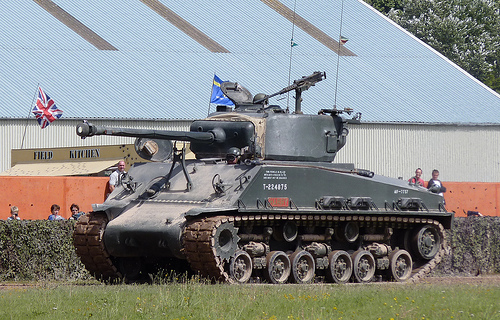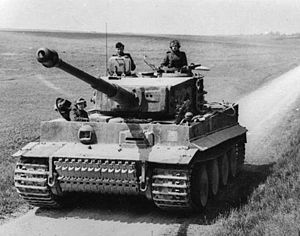Veterans Day seems to be a good day to consider war movies. We saw the movie Fury last night and it was technically pretty good. A couple of folks on veteran sites complained about the haircuts but I don’t know if they would have been different in April 1945 in guys who had been fighting all the way from the Normandy beaches. I objected a bit to the tank they used as it looked like the Sherman Firefly that the British used. However, the movie web site says it was an M4 A2E8 which does look like the Firefly.
The combat scenes were intense and looked authentic to me. They even had a Tiger I from a museum in Britain. Most tanks that I see in Movies, including Patton, are not authentic Shermans.
The tactics looked pretty good as they showed that Shermans had to get around the Tiger Tank to attack the rear where the armor was thinner. The Russians used the same tactics with their T 34 which was the best tank of the war.
The story was about the same plot as Saving Private Ryan although some of the objectionable lines, like saving Ryan was “the only good thing that will come out of this war,” as if Hitler was not a good reason. The plot device is basically the same with the new guy as an innocent who survives and the experienced guys all get killed.
My list of war movies is pretty old. One of the first that was not just war propaganda was “They Were Expendable,” the story of the PT boats in the early days of the war. The Director was John Ford, who was a reserve Captain with experience shooting film at Midway during the battle. He was also one of the great directors of all time. One of the stars was Robert Montgomery who had commanded a PT boat in the war.
The next notable war movie was 12 O’Clock High, which starred Gregory Peck as General Frank Savage. The character was based on a composite of Colonel Frank Armstrong who did take over a failing group and got it back into fighting trim.
As a “trouble-shooter” for Eaker, on July 31, 1942, Armstrong relieved Colonel Cornelius W. “Connie” Cousland of command of the inadequately-trained 97th Bomb Group, the first group of B-17 Flying Fortress bombers sent to England, and put it through an intensive training period at RAF Polebrook. He then led it in combat on six of its first 10 missions from August 17 to September 2, 1942. Armstrong led the first daylight heavy bomber raid made by the USAAF over Occupied Europe, receiving the Silver Star and an oak leaf cluster to the Distinguished Flying Cross. He was also awarded the British Distinguished Flying Cross for the initial mission, the first U.S. officer to be so honored.
The other person in the composite was Paul Tibbets who actually flew the plane on the first mission into Europe and who also dropped the atomic bomb on Japan.
He flew the lead plane in the first American daylight heavy bomber mission against Occupied Europe on August 17, 1942, and the first American raid of more than 100 bombers in Europe on October 9, 1942. Tibbets was chosen to fly Major General Mark W. Clark and Lieutenant General Dwight D. Eisenhower to Gibraltar. After flying 43 combat missions, he became the assistant for bomber operations on the staff of the Twelfth Air Force.
The staff position was held by the fictional Frank Savage before taking over the group, actually modeled on the 306th Group. The movie called it the 918th, three times the 306. The group that Armstrong retrained was the 97th Bomb Group, now renamed with a new mission but in 1942:
The group was established early in 1942 and initially trained B-17 crews in Florida and flew antisubmarine patrols. It deployed to England as part of Operation Bolero and became the first operationally-ready Eighth Air Force B-17 Flying Fortress group.
Combat operations by the group began on 17 August 1942, when the 97th Bomb Group flew the first Eighth Air Force heavy-bomber mission of the war, attacking the Rouen-Sotteville marshalling yards in France. The mission included 18 bombers – 12 to attack the yards and six to fly a diversion along the coast.
The lead aircraft of the group, Butcher Shop, was piloted by the Group Commander, Colonel Frank A. Armstrong, and Squadron Commander, Major Paul W. Tibbets, who later flew the Enola Gay to Hiroshima, Japan on the first atomic bomb mission.
The movie was based on a novel written by two men who had served with a bomb group and who knew what they were writing about.
Screenwriters Bartlett and Lay drew on their own wartime experiences with Eighth Air Force bomber units. At the Eighth Air Force headquarters, Bartlett had worked closely with Colonel Armstrong, who was the primary model for the character General Savage. The film’s 918th Bomber Group was modeled primarily on the 306th because that group remained a significant part of the Eighth Air Force throughout the war in Europe.
Veterans of the heavy bomber campaign frequently cite Twelve O’Clock High as the only Hollywood film that accurately captured their combat experiences.
The next notable war movie in my own experience was Battleground, another 1949 film and one that has always struck me as authentic.
The film is notable for portraying American soldiers as vulnerable and human, as opposed to just inspirational and gung-ho. While there is no question about their courage and steadfastness, each soldier has at least one moment in the film when he seriously considers running away, schemes to get sent away from the front line, slacks off, or complains about the situation he is in. Battleground is considered to be the first significant film about World War II to be made and released after the end of the war.
It introduces the theme of the newcomer to a combat unit.
The stars include John Hodiak, who did a good job although he had no war experience. He died suddenly at the age of 41 a few years later. Other notable characters were played by Van Johnson, and James Whitmore, in what I consider the best role in the film, plus a nice cast of an ensemble movie.
The next one that I consider authentic and historically very accurate was The Longest Day, and which was based on Cornelius Ryan’s bestseller which I have read several times. The cast was huge, even including a young Sean Connery, and I have visited many of the locations.
Looking at the bluffs at Omaha Beach, it is easy to see how the troops were in deep trouble.
Utah Beach was not the same geography and here the casualties were far fewer. The movie has been criticized mainly, and mainly since “Saving Private Ryan,” for not emphasizing the intense fire on the beach at Omaha. However, in my opinion, the accuracy of the history is still a major feature. I have driven all over Normandy and seen many of the sites of real battle.
For the rest, I have consulted a web site listing other war movies.
Sands of Iwo Jima is another 1949 war film with John Wayne in what I thought was a well acted role. Critical reception was good and Wayne was even nominated for an Oscar.
Compared to most combat films of its time, Sands of Iwo Jima was fairly nuanced in its view of war and military people. Ironically, many references to it in mass media and popular culture depict it as the quintessential “flag-waving” World War II film. This may have less to do with the movie’s actual contents than with star John Wayne’s later identification with conservative politics.
The subject of Patton is a favorite of mine as I have read a number of biographies of George S Patton Jr. The film is marred by the influence of Omar Bradley who hated Patton and appears as an avuncular uncle to the brash teenager, Patton. Bradley’s military reputation has been in decline the past few years and deservedly so, in my opinion. I’m not the only one.
Omar Bradley served as a consultant for the film, though the extent of his influence and input into the final script is largely unknown. While Bradley knew Patton personally, it was also well known that the two men were polar opposites in personality, and there is evidence to conclude that Bradley despised Patton both personally and professionally. As the film was made without access to General Patton’s diaries, it largely relied upon observations by Bradley and other military contemporaries when attempting to reconstruct Patton’s thoughts and motives. In a review of the film, S.L.A. Marshall, who knew both Patton and Bradley, stated that “The Bradley name gets heavy billing on a picture of comrade that, while not caricature, is the likeness of a victorious, glory-seeking buffoon. … Patton in the flesh was an enigma. He so stays in the film.
Patton’s widow had just died when the screenwriters asked for access to his dairies. The family refused access. Some of that might be due to his relationship with his adoring niece, Jean Gordon, who was very close to him and managed to get to England by volunteering for the Red Cross. There are rumors of a sexual relationship and something might have been in the diaries. He was a very interesting character and the movie is a classic although badly flawed through Bradley’s influence.
The next on my list is The Bridge on the River Kwai. I read this book when I was in high school and the movie was very well done. It is, of course based on the story of the Burma Siam Railroad, where over 40,000 prisoners died.
“The notorious Burma-Siam railway, built by Commonwealth, Dutch and American prisoners of war, was a Japanese project driven by the need for improved communications to support the large Japanese army in Burma. During its construction, approximately 13,000 prisoners of war died and were buried along the railway. An estimated 80,000 to 100,000 civilians also died in the course of the project, chiefly forced labour brought from Malaya and the Dutch East Indies, or conscripted in Siam (Thailand) and Burma. Two labour forces, one based in Siam and the other in Burma, worked from opposite ends of the line towards the centre.”
The movie is considered by some to be a parody of the British commander of the POWs.
The real senior Allied officer at the bridge was British Lieutenant Colonel Philip Toosey. Some consider the film to be an insulting parody of Toosey. On a BBC Timewatch programme, a former prisoner at the camp states that it is unlikely that a man like the fictional Nicholson could have risen to the rank of lieutenant colonel; and if he had, due to his collaboration he would have been “quietly eliminated” by the other prisoners. Julie Summers, in her book The Colonel of Tamarkan, writes that Pierre Boulle, who had been a prisoner of war in Thailand, created the fictional Nicholson character as an amalgam of his memories of collaborating French officers.
The best movie about the Korean War is The Steel Helmet, which has a theme a bit like Battleground.
When an American infantry unit surrenders to the North Koreans, the prisoners of war have their hands bound behind their backs and are then executed. Only Sergeant Zack (Gene Evans) survives the massacre, saved when the bullet meant for him is deflected by his helmet. He is freed by South Korean orphan (William Chun), nicknamed “Short Round” by Zack, who tags along despite the sergeant’s annoyance.
Gene Evans does a good job in a role very much like James Whitmore in “Battleground.” The movie was controversial but in a way that seems fine to me.
In October 1950, Fuller made his film in ten days with twenty-five extras who were UCLA students and a plywood tank, in a studio using mist, and exteriors shot in Griffith Park for $104,000. According to Ben Mankiewicz of Turner Classic Movies, Fuller wrote the script in a week. The Steel Helmet grossed more than $6 million.
The Steel Helmet confronts American racism when a North Korean Communist prisoner baits a black soldier in conversation with accounts of American society’s Jim Crow rules. Moreover, the Korean soldier makes the first-ever mention, in a Hollywood film, of the internment of Japanese Americans in World War II. The film infuriated the military who had provided assistance in the form of military stock footage. Army personnel summoned Fuller for a conference on the film. The U.S Army was upset over Sgt. Zack’s shooting of a prisoner of war. Fuller replied that in his World War II service it frequently happened, and had his former commanding officer, Brigadier General George A. Taylor, telephone the Pentagon to confirm it. In contrast, the Communist newspaper, The Daily Worker condemned The Steel Helmet as a right-wing fantasy.
MASH was not really a war movie and I have told people, usually to their shock, that I consider it one of the best medical movies I’ve seen. It is set in Korea but it is really a Vietnam movie.
There are other excellent war movies but these are the ones I like and would see again. In fact, I have a number of them on DVD and watch them occasionally.
Tags: History





Have you heard the chatter that Patton was murdered in a plot orchestrated by Stalin (recent Bill O’Reilly book and other places)?
I’ve heard it but don’t take it seriously. The guy who took care of him after he was injured in that freak truck accident was a famous British neurosurgeon.